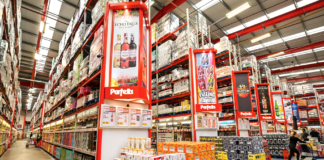In his book, Leap of Strength, US business coach Walt Sutton recommends you visualise the river of cash from which your business will draw income.
The object is to be in the best place to capture the most water. So you pay attention to the river. If someone builds a dam upstream or if it switches course, threatening to leave you in an oxbow lake, you take action.
Obviously, in wholesale, the rivers of cash have manufacturers upstream and consumers downstream. But the river is restricted by rival systems such as the supermarkets and Amazon.
Downstream wholesalers can focus on retail or foodservice outlets, with various levels of complexity for both. Retail tends to be a channel driven by ‘always something new’, foodservice by seasonal twists on a core proposition.
In a curious way, the system suffers from both over-capacity and a lack of choice – to quote wholesaler Barbara Henderson of Lomond Foods (Better Wholesaling, June 2018), there is too much availability of “cheap brown boxes”. This colours how the current wave of consolidation will play out.
Locking retailers into symbol group affiliation is a big driver of long-term security of sales but perhaps risks encouraging complacency. If a retailer is in your symbol group and buys £10,000 of goods from you a week, you can be fairly certain of that revenue for around 500 weeks into the future. But the product mix you sell may not change much and may not be what the retailer’s shoppers are looking for.
While there is plenty of media coverage of those retailers who are investing in ‘foodvenience’ (food for now and food to go), they are few in number and the wholesale service they require is vastly different to that currently on offer.
The strategic pressures brought by the Tesco-Booker tie-up are mainly being explained in terms of the ‘cheap brown boxes’ model. As Tesco-Booker squeezes margins from big brands, so the big brands may disadvantage wholesale by trimming margins.
An obvious counter-play is to provide retailers with a better service that helps them engage with foodvenience. This includes smaller and more frequent deliveries of chilled and fresh products. However, many of the retailers most inclined to buy into such an offer – and to make a go of foodvenience – are locked into symbol deals. And history shows they are very reluctant to change.
By providing a better service to retailers, you can help them move their offering into the more attractive fresh and food-for-now space that experts say will provide more sales and profits in the future. But you need to think hard about how to differentiate your offer.
The key thing here is to focus on customer experience rather than service. Better availability – a service – is hard to prove, because there are well-known industry targets in the high 95%-98% range that are easily manipulated.
Instead the focus needs to be on capturing how the experience of using your services is better – for example, by letting customers know about alternatives if a product is not available. While the attitude in wholesale may be that everyone is fighting hard for every sale, week in, week out, the market that you are selling into is changing fast. So, working closely with customers to keep them on trend or ahead is a good investment.
Every time you find yourself talking about low price (unless you are just competing on price), pinch yourself and ask if this is keeping you in a river that will last or pushing you into tricky waters.
Wholesale expert Nick Shanagher is the managing director of Newtrade
Read similar: Wholesalers: Ditch the brown box mentality, and think fresh







